Italian diva Maria Jacobini stars as a poor country girl in the silent drama La bocca chiusa/The closed mouth (Guglielmo Zorzi, 1925). Lido Manetti aka Arnold Kent plays a British duke who seduces her. Later, her stepfather sells her child to the duke, making her believe the child died.
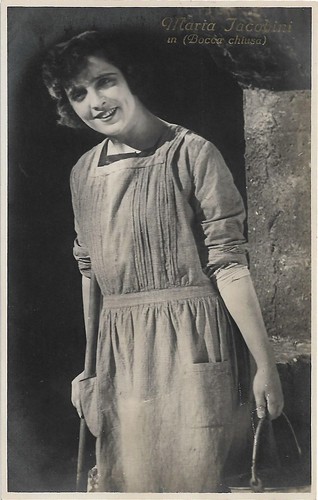
Italian postcard by G.B. Falci, Milano. Photo: SAIC. Publicity still of Maria Jacobini in La bocca chiusa/The closed mouth (Guglielmo Zorzi, 1925).
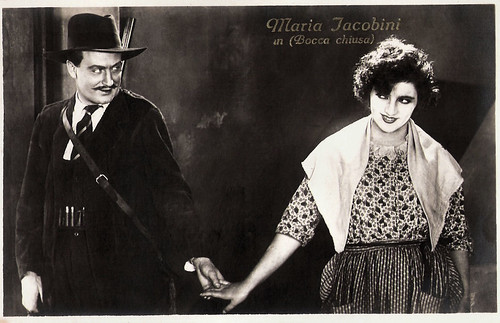
Italian postcard by G.B. Falci, Milano. Photo: SAIC. Publicity still of Maria Jacobini and Lido Manetti in La bocca chiusa/The closed mouth (Guglielmo Zorzi, 1925).
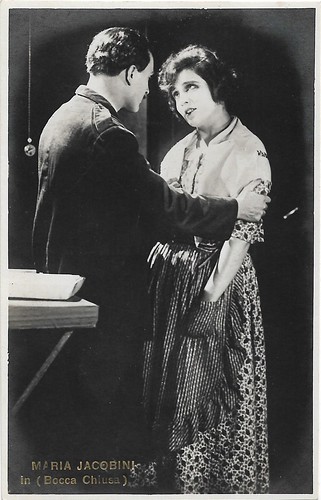
Italian postcard by G.B. Falci, Milano. Photo: SAIC. Publicity still of Maria Jacobini and Lido Manetti in La bocca chiusa/The closed mouth (Guglielmo Zorzi, 1925).
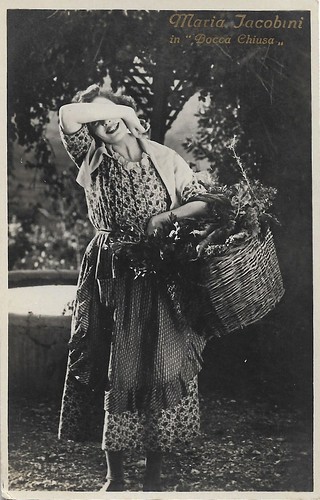
Italian postcard by G.B. Falci, Milano. Photo: SAIC. Publicity still of Maria Jacobini in La bocca chiusa/The closed mouth (Guglielmo Zorzi, 1925).
Director Guglielmo Zorzi himself wrote the story for La bocca chiusa//The closed mouth (Guglielmo Zorzi, 1925). His film was produced by the S.A.I.C., which also produced La cavalcata ardente (Carmine Gallone, 1925) in the same year.
In La bocca chiusa, Lido Manetti plays a British duke who seduces a poor country girl (Maria Jacobini). Her stepfather (Augusto Poggioli) sells her child to the duke, making her believe the child died.
With the money, he embellishes his house, but when the girl finds out, she goes mad, burns down the house and becomes a wanderer.
Twenty years after, her son (Lido Manetti again) lovingly takes her into his service, not knowing who she is. She recognises a picture, though, and not wanting to destroy his happiness, she silently goes away.
Maria Jacobini (1892-1944) was an island of serenity among the divas of the Italian silent cinema, as film historian Vittorio Martinelli expressed it. She was the personification of goodness, of simple love. Her weapon was her sweet and gracious smile.
Lido Manetti (1899-1928) also had a prolific career in the Italian silent cinema. He was then brought to Hollywood as a young leading man under the name of Arnold Kent. Sadly, he died before he could live up to his promise.

Italian postcard by G.B. Falci, Milano, no. 348. Maria Jacobini in La bocca chiusa/The closed mouth (Guglielmo Zorzi, 1925).
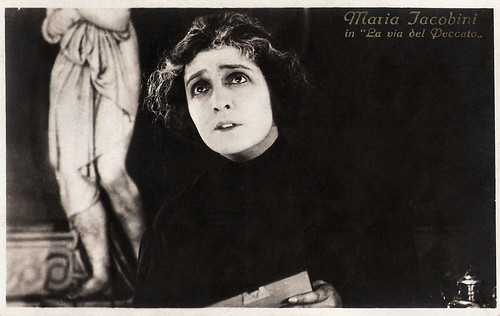
Italian postcard by G.B. Falci, Milano. The film title on this card is a mystery. Maria Jacobini did not play in La via del peccato (Amleto Palermi 1925), but her sister Diomira Jacobini did. Maria acted in a film called L'onestà del peccato (Augusto Genina, 1918). But this is probably a card for La bocca chiusa/The closed mouth (1925), for the moment when the aged Maria, now a domestic to a lord, sees a childhood photo and realises her employer is her own son.
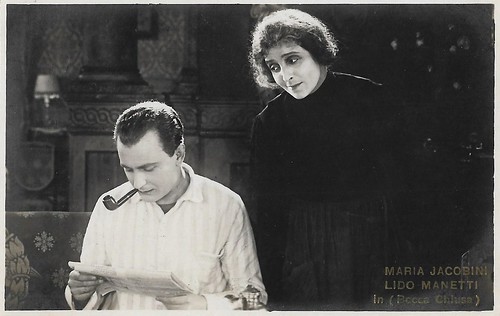
Italian postcard by G.B. Falci, Milano. Photo: SAIC. Publicity still of Maria Jacobini and Lido Manetti in La bocca chiusa/The closed mouth (Guglielmo Zorzi, 1925).
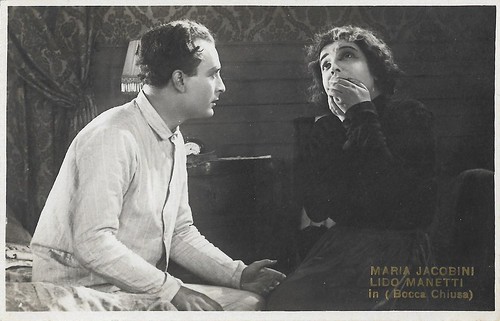
Italian postcard by G.B. Falci, Milano. Photo: SAIC. Publicity still of Maria Jacobini and Lido Manetti in La bocca chiusa/The closed mouth (Guglielmo Zorzi, 1925).
Sources: Wikipedia and IMDb.

Italian postcard by G.B. Falci, Milano. Photo: SAIC. Publicity still of Maria Jacobini in La bocca chiusa/The closed mouth (Guglielmo Zorzi, 1925).

Italian postcard by G.B. Falci, Milano. Photo: SAIC. Publicity still of Maria Jacobini and Lido Manetti in La bocca chiusa/The closed mouth (Guglielmo Zorzi, 1925).

Italian postcard by G.B. Falci, Milano. Photo: SAIC. Publicity still of Maria Jacobini and Lido Manetti in La bocca chiusa/The closed mouth (Guglielmo Zorzi, 1925).

Italian postcard by G.B. Falci, Milano. Photo: SAIC. Publicity still of Maria Jacobini in La bocca chiusa/The closed mouth (Guglielmo Zorzi, 1925).
The sad tale of a poor country girl
Director Guglielmo Zorzi himself wrote the story for La bocca chiusa//The closed mouth (Guglielmo Zorzi, 1925). His film was produced by the S.A.I.C., which also produced La cavalcata ardente (Carmine Gallone, 1925) in the same year.
In La bocca chiusa, Lido Manetti plays a British duke who seduces a poor country girl (Maria Jacobini). Her stepfather (Augusto Poggioli) sells her child to the duke, making her believe the child died.
With the money, he embellishes his house, but when the girl finds out, she goes mad, burns down the house and becomes a wanderer.
Twenty years after, her son (Lido Manetti again) lovingly takes her into his service, not knowing who she is. She recognises a picture, though, and not wanting to destroy his happiness, she silently goes away.
Maria Jacobini (1892-1944) was an island of serenity among the divas of the Italian silent cinema, as film historian Vittorio Martinelli expressed it. She was the personification of goodness, of simple love. Her weapon was her sweet and gracious smile.
Lido Manetti (1899-1928) also had a prolific career in the Italian silent cinema. He was then brought to Hollywood as a young leading man under the name of Arnold Kent. Sadly, he died before he could live up to his promise.

Italian postcard by G.B. Falci, Milano, no. 348. Maria Jacobini in La bocca chiusa/The closed mouth (Guglielmo Zorzi, 1925).

Italian postcard by G.B. Falci, Milano. The film title on this card is a mystery. Maria Jacobini did not play in La via del peccato (Amleto Palermi 1925), but her sister Diomira Jacobini did. Maria acted in a film called L'onestà del peccato (Augusto Genina, 1918). But this is probably a card for La bocca chiusa/The closed mouth (1925), for the moment when the aged Maria, now a domestic to a lord, sees a childhood photo and realises her employer is her own son.

Italian postcard by G.B. Falci, Milano. Photo: SAIC. Publicity still of Maria Jacobini and Lido Manetti in La bocca chiusa/The closed mouth (Guglielmo Zorzi, 1925).

Italian postcard by G.B. Falci, Milano. Photo: SAIC. Publicity still of Maria Jacobini and Lido Manetti in La bocca chiusa/The closed mouth (Guglielmo Zorzi, 1925).
Sources: Wikipedia and IMDb.
1 comment:
Hello, my Friend! It's been awhile since I've visited. I've been through some pretty deep waters over the past year. What a delight to find your blog again--and peruse your wonderful finds and the history behind them.
I hope this note finds you well.
Post a Comment